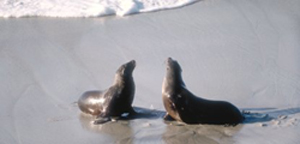Deep Sea Waters

Common Name: California Sea Lion
Scientific Name: Zalophus californianus
Description
California sea lions (Zalophus californianus californianus) are large marine mammals in the pinniped family, which includes seals and walruses. Male California sea lions can measure eight feet long and reach a weight of 1,000 pounds or more. Females can reach six feet in length and weigh up to 250 pounds.
California sea lions are one of two species of sea lions found in Washington state waters, the other being Steller sea lions (Eumetopias jubata), which are larger in size.
California Sea Lion Range
California sea lions are found from the southern tip of Baja California to southeast Alaska. They breed mainly on offshore islands from southern California's Channel Islands south to Mexico. Non-breeding males often roam north in spring foraging for food. Since the mid-1980s, increasing numbers of California sea lions have been documented feeding on fish along the Washington coast and - more recently - in the Columbia River as far upstream as Bonneville Dam, 145 miles from the river mouth.
California Sea Lion Population
The U.S. population of California sea lions is currently estimated at up to 300,000 animals, all on the Pacific coast. From an estimated population of about 10,000 animals in the 1950s, U.S. California sea lion numbers have grown rapidly since the 1970s and the species is now at "carrying capacity"-near the highest level the environment can sustain-according to wildlife biologists. A population survey conducted in 2006 by the Washington Department of Fish and Wildlife (WDFW) documented 1,200 California sea lions and 1,000 Steller sea lions near the mouth of the Columbia River alone.
California Sea Lion Diet

California sea lions feed on a variety of fish and shellfish, including salmon, steelhead, Pacific whiting, herring, mackerel, eulachon, lamprey, codfish, walleye Pollock, spiny dogfish and squid. In recent years, they have also been observed preying on Columbia River sturgeon. Studies of scat samples collected in coastal waters and the Columbia River estuary indicate that salmon comprise 10 to 30 percent of the animals' diet. Additional studies have shown that the percentage of salmon and steelhead in sea lions' diet increases as they move upriver. Each year since 2004, California sea lions have consumed 3,000 to 3,500 salmon and steelhead immediately below Bonneville Dam, according to an ongoing study by the U.S. Army Corps of Engineers.
California Sea Lion Conservation Status
Like all marine mammals, California sea lions are managed under the federal Marine Mammal Protection Act (MMPA) of 1972. They are not, however, designated as a "depleted" population under the MMPA, nor are they listed for protection under the Endangered Species Act (ESA). While the MMPA was intended to protect marine mammals from human interference, the law was amended in 1994 to provide a process for states to lethally remove individual California sea lions that threaten recovery of salmon and steelhead stocks listed for protection under the ESA. This provision does not apply to Steller sea lions, which are listed as "threatened" under the ESA.
Additional Information
California sea lions, Zalophus californianus, are probably the most familiar marine mammal at the islands. These smart, playful animals are often seen playing in the surf or lounging on beaches around San Miguel, Anacapa, and Santa Barbara Islands in particular. Males may reach 8 feet in length and 1000 lbs, females about 220 lbs. They are easily recognized by their pointed nose, external ear flap, "Charlie Chaplin" walk, and loud sometimes incessant barking. Sea lions are very social animals. They can be quite curious in the water coming to investigate divers and boats. On the breeding they are very skittish and will retreat into the water if disturbed. Males set up beach territories and defend their harems from other males. Pups are generally born in June and July and females nurse their pups for nearly year. Sea lions feed on fish and squid near the surface generally but can dive to 500 ft. The 2001 population of California sea lions was estimated at about 200,000 and 80,000 might live at San Miguel Island. The population has been growing steadily since 1975 except for set backs in El Nio years.
 Deep Sea Crabs
Deep Sea Crabs